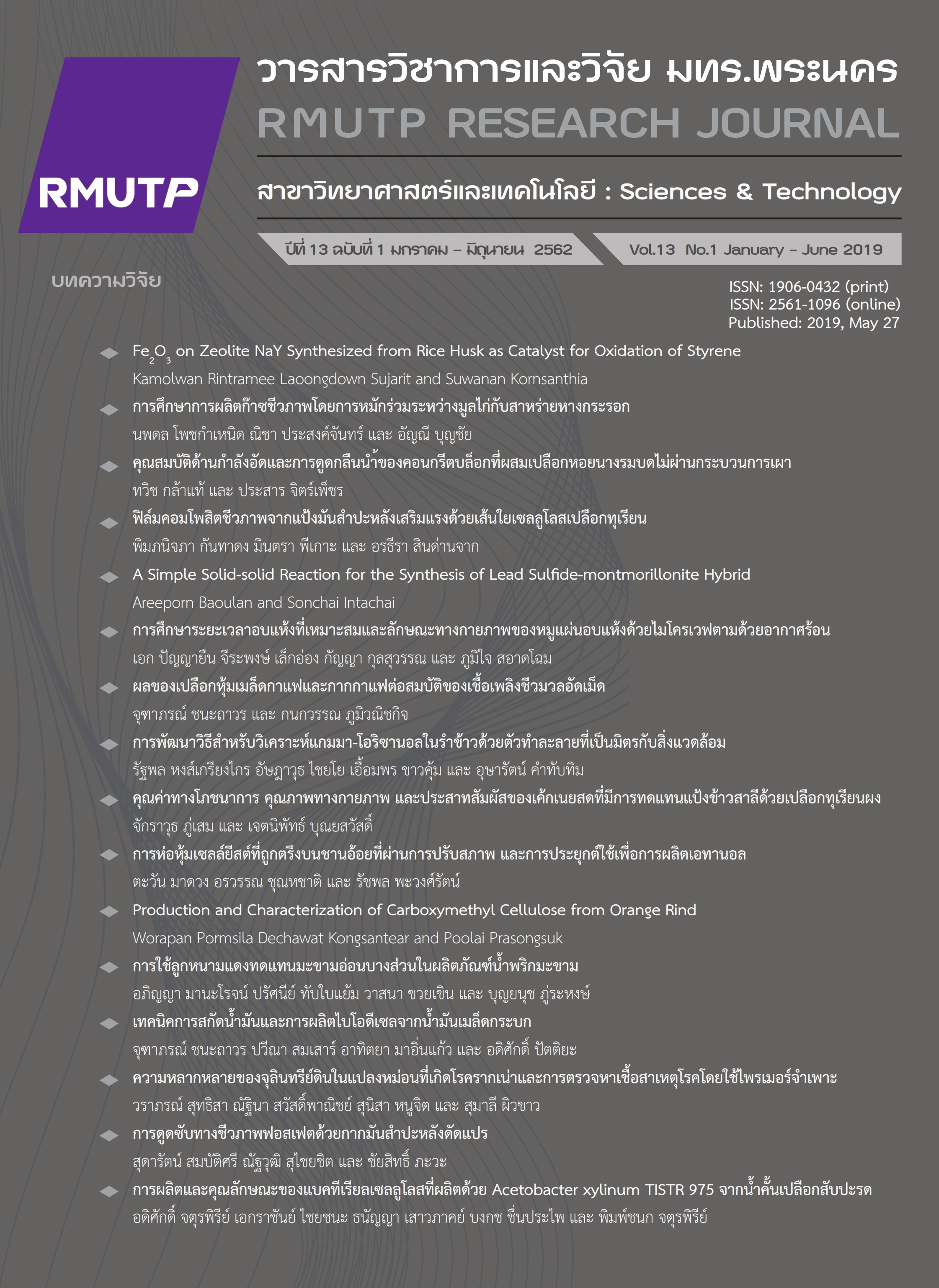ความหลากหลายของจุลินทรีย์ดินในแปลงหม่อนที่เกิดโรครากเน่าและการตรวจหาเชื้อสาเหตุโรคโดยใช้ไพรเมอร์จำเพาะ
Main Article Content
บทคัดย่อ
การวิจัยนี้มีจุดประสงค์เพื่อศึกษาความหลากหลายของจุลินทรีย์ดินในแปลงหม่อนที่เกิดโรครากเน่าจากศูนย์หม่อนไหมเฉลิมพระเกียรติสมเด็จพระนางเจ้าสิริกิติ์พระบรมราชินีนาถ (ศมม.) 4 ศูนย์ ได้แก่ กาญจนบุรี ขอนแก่น ศรีสะเกษ และอุบลราชธานี ทำการแยกเชื้อจุลินทรีย์บนอาหารเลี้ยงเชื้อ 4 ชนิด ได้แก่ Nutrient agar (NA), Potato dextrose agar (PDA), Rose bengal agar (RBG) และ Modified selective fusarium agar (SFA) สามารถแยกเชื้อแบคทีเรียบนอาหาร NA ได้ 24 ไอโซเลต ประกอบด้วย แบคทีเรียแกรมบวก รูปร่างท่อน มีเอนโดสปอร์แบคทีเรียแกรมลบ รูปร่างท่อน แบคทีเรียแกรมบวก รูปร่างกลม และ Actinomycetes นอกจากนี้ยังสามารถแยกเชื้อราได้ทั้งหมด 75 ไอโซเลต บนอาหาร PDA, RBG และ SFA ผลการจำแนกด้วยลักษณะทางสัณฐานวิทยา พบว่าเป็นเชื้อราชนิดต่างๆ ได้แก่ Aspergillus sp., Chaetomium sp., Curvularia sp., Fusarium sp., Penicillium sp., Phytophthora sp. และ Rhizopus sp. ส่วนการตรวจสอบยืนยันเชื้อรา Fusarium sp. ด้วยไพรเมอร์จำเพาะต่อ F. solani ที่เป็นสาเหตุโรครากเน่าหม่อน พบแถบดีเอ็นเอขนาดประมาณ 300 คู่เบส ในทุกไอโซเลต แสดงว่า Fusarium spp. ที่แยกได้นั้นคือ F. solani
Article Details
เอกสารอ้างอิง
[2] J.S. Singh, V.C. Pandey and D.P. Singh, “Efficient soil microorganisms: A new dimension for sustainable agriculture and environmental development,” Agriculture, Ecosystems & Environment, vol. 140, no. 3-4, pp. 339-353, March. 2011.
[3] S. Nimrat, Soil Microbiology, 1st ed. Bangkok: Odeon Store, 2016
[4] P. Hongtongdang, S. Akarapun, S. Chansanfsri and S. Tangrattanaprasert, “Testing of mulberry cultivar that resistant to root rot,” in 2016 Annual Research, The Queen Sirikit Department of Sericulture.
[5] N. Sanoamuang, W. Saksirirat and P. Siritorn, “Study of mulberry root rot disease in the future,” Khon Kaen Agricultural Journal, vol. 15. no. 2, pp. 63-68, 1987.
[6] W. Sutthisa and N. Sanoamuang, “Pathogenicity and Molecular Detection of Fusarium solani Form A and B on Root Rot of Mulberry,” KKU Research Journal, vol. 16, no. 3, pp. 203-214, March. 2011.
[7] W. Sutthisa, N. Sanoamuang and S. Chooprayoon, “Morphological and molecular characterization of Fusarium spp., the fungi associated with mulberry root rot disease in northeastern Thailand” Thai Journal of Botany, vol. 2, no. 1, pp. 25-39, 2010.
[8] J. Wang, F. Kong, T. Zhao, C. Zhang, S. Zhang and C. Feng, “First report of tobacco root rot caused by Gelasinospora reticulate”. Crop Protection, vol. 66, pp. 86-89, Dec. 2014.
[9] K.F. Chang, S.F. Hwang, H.U. Ahmed, Q. Zhou, S.E. Strelkov, R.L. Conner, D.L.McLaren, M.A. Henriquez, M.W. Harding and G.D. Turnbull, “First report of Phytophthora sojae causing root rot in soybean [Glycine max (L.) Merr.] in Alberta, Canada,” Crop Protection, vol. 91, pp. 49-56, Jan. 2017.
[10] W. Sutthisa, “Etiology of Fusarium species on mulberry root rot disease and development of specific primer for detection of the pathogen,” Ph.D. dissertation, Dept. Plant patho., Khan Kaen Univ., Khon Kaen, 2010.
[11] Z. Zhang, J. Zhang, Y. Wang and X. Zheng, “Molecular detection of Fusarium oxysporum f.sp. niveum and Mycosphaerella melonis in infected plant tissues and soil,” FEMS Microbiology Letters, vol. 249, no. 1, pp. 39-47, Aug. 2005.
[12] M.J. Brimecombe, F.A.A.M. De Leij and J.M. Lynch, Rhizodeposition and microbial populations. Then rhizosphere biochemistry and organic substances at the soil-plant interface., Taylor & Francis Group, New York: CRC Press 2007.
[13] B. Petsuriyawong, N. Khunajakr and A. Wongwicham, “Isolation and identification of antifungal bacteria from soil,” in Proceeding of 50th Kasetsart University Annual Conference: Science, Natural Resources and Environment, Kasetsart University, Thailand, 2012.
[14] F.R. Passamani, T. Hernandes, N.A. Lopes, S.C. Bastos, W.D. Santiago and L.R. Batista, “Effect of temperature, water activity, and pH on growth and production of ochratoxin A by Aspergillus niger and Aspergillus carbonarius from Brazilian grapes,” J. Food Prot. Vol. 77, no. 11, pp. 1947-52, Nov. 2014.
[15] S. Sontirat, Plant Disease Management, 1st ed. Bangkok: V.B. Book Center, 1997.
[16] R.K. Mishra, B.K. Pandey, M. Muthukumar, N. Pathak and M. Zeeshan, “Detection of Fusarium wilt pathogens of Psidium guajava L. in soil using culture independent PCR (ciPCR),” Saudi journal of biological sciences, vol. 20 no.1, pp. 51-56, Jan. 2013.


